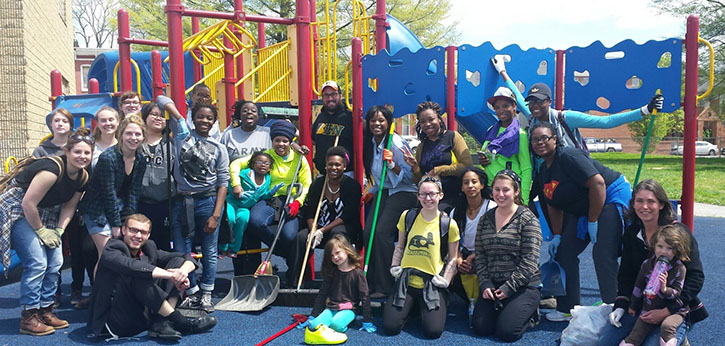IEL’s Coalition for Community Schools (CCS) announced the winners of its bi-annual National Community Schools Awards for Excellence. The seven winners demonstrate that joint school and community action can bolster student achievement and more.
IEL’s Coalition for Community Schools (CCS) announced the winners of its bi-annual National Community Schools Awards for Excellence. CCS’s work involves focusing on what happens when schools, families, and communities collaborate to offer the most vulnerable youth new opportunities while addressing barriers that keep them from succeeding.
The seven winners demonstrate that community ownership and joint school and community action can bolster student achievement and development, improve outcomes for families, and unite neighborhoods.
Each of the winners, which include both individual schools and multi-site community initiatives, brings a unique story of success. Organized to respond to local conditions, these awardees are tackling some of today’s most pressing issues that influence young people’s development: poverty, safety, and equitable access to opportunities. The awardees demonstrate how public schools can become community hubs that bring together educators, families, and community partners to offer a range of opportunities and supports to families, communities, and young people. The awardees are:
Family League of Baltimore, Md., in partnership with Baltimore City Public Schools and the Mayor and City Council, currently has 45 community schools across the city, each with a full-time community school coordinator, that provide students with health and mental health supports, after-school programs, and access to food, among other services. These efforts have contributed to reducing chronic absenteeism and increasing student participation in after-school programs. The Baltimore City Council recently passed a resolution urging the mayor to increase the budget for community schools and out-of-school programs to $10 million, a $4 million dollar increased investment.
United Way of Salt Lake, Utah, working within three, and soon to be four districts in the Salt Lake area, has helped increase student achievement and graduation rates. At one of United Way’s partner schools, Granite Park Junior High, the percentage of students completing 9th grade on track to graduate has more than doubled in just two years. Their efforts also have increased preschool opportunities in their poorest neighborhoods. Seeing this works as a collective impact strategy, United Way has put more than $21.5 million toward the initiative since 2012 and has set a goal of having 28 community schools in the region by 2017.
Benjamin Franklin High School at Masonville Cove in Baltimore, Md. moved from one of the city’s lowest performing high schools to one of Baltimore’s top choice high schools between 2011 and 2015. From an early childhood education program for parenting teens to workforce development for community members, a network of over 75 partners customize responses to needs presented by students and families. Students clocked more than 17,000 service learning hours last school year and are credited with stopping the building of a waste incinerator near their campus through community organizing.
The Historic Samuel Coleridge-Taylor Elementary School in Baltimore, Md. has over 95% of its students receiving free or reduced lunch. Since becoming a community school in 2011, they have seen their school readiness scores rise. Teachers and staff made over 100 home visits last year and over 200 teachers from Taylor and other Baltimore schools participated in a trauma-informed behavior management skills trainings through the school’s partnership with the University of Maryland School of Social Work.
John Hancock College Preparatory High School in Chicago, Ill. has increased its social-emotional support for students through the Becoming a Man program, as well as opportunities for them to exercise leadership skills. It is paying off in the form of attendance rates increasing from 70 percent in 2010 to 90% last year, decreased dropout rates, and the five-year graduation rate improving by 20%. Hancock also has implemented robust mental health supports with the help of its lead partner, Youth Guidance. All their efforts combined has led to a positive school climate and culture.
Social Justice Humanitas Academy in Los Angeles, Calif. has raised its graduation rate from 83% to 93.9% in the last year. Only 2 of its 509 students were suspended last year thanks to its model practices around restorative justice, interdisciplinary teaching, relevant curriculum, and relationship building. An Individualized Pupil Education Plans (IPEP) defines how teachers and community partners can best help struggling students and reflects the close relationships between students and teachers. By graduation day, 99% of the Class of 2014 had enrolled in college.
Wolfe Street Academy in Baltimore, Md. has moved from the 77th to the 2nd highest performing elementary school in Baltimore since adopting the community schools strategy nine years ago. Partnership provide students greater access to after-school learning opportunities through ExpandED, social work support and a new library. Student mobility has decreased from 46.6-8.8% in eight years, and average daily attendance is 96%.
Together, these high-performing community schools honored this year serve more than 33,000 students and their families in some of the most diverse and economically challenging neighborhoods in the country. From coast to coast this year’s winners, represent the changing demographics of the country and the need to be responsive to specific community needs.
“People are taking notice,” says Martin Blank, CCS director and IEL president. “The community school movement continues to grow because folks are looking at their schools and realizing that the only way to get young people the opportunities they deserve is through partnership with the community. These winners represent the best of what can be done with teamwork and ingenuity in America’s communities.”
Nationwide, community schools in nearly 100 places are using partnerships to make more effective and efficient use of resources and providing innovative and high-quality instruction and support for their students. They are seeing results such as higher attendance, lower suspension and expulsion rates, increased testing scores, and more trust among families with the school.
Learn more about the awardees.
